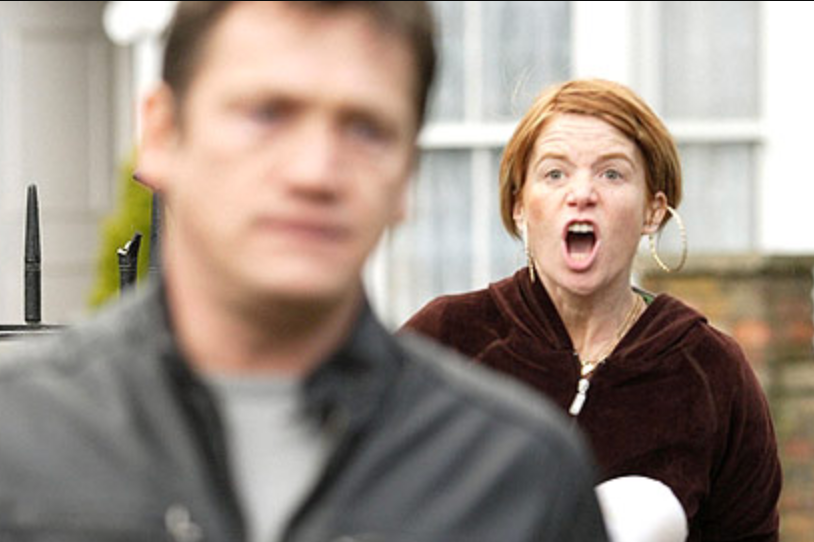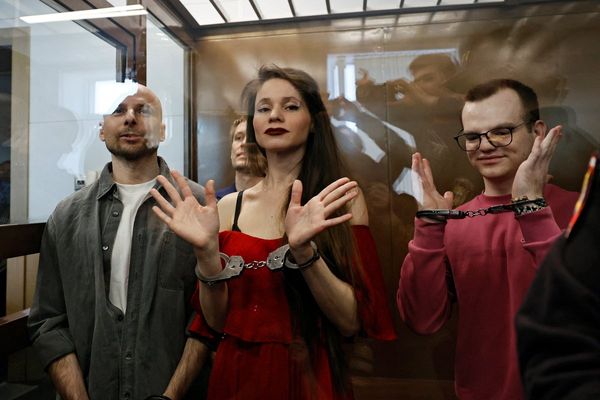
When EastEnders launched on BBC One in 1985, Britain’s most popular soap operas were being imported from America. Dynasty and Dallas both peddled televised fantasies of extreme wealth, atrocious behaviour and shoulder pads you could land a helicopter on. Then, on a gloomy February evening, came EastEnders, a soap set in working-class London which began with three men – a cabbie, a publican and an out-of-work gardener – breaking down the door of a dank bedsit where a man lay dead in an armchair. This homegrown series was billed as a cockney Coronation Street but the vibe was positively Dickensian.
Now Dallas and Dynasty are a distant memory (failed reboots notwithstanding), but EastEnders, which this week celebrates its 40th anniversary, lives on. It may no longer pull the audiences of its heyday – 30.1 million tuned in to watch Dirty Den serve his wife divorce papers on Christmas Day 1986 – but it remains an institution, as reliable in the TV schedules as the News at Six.
When that first episode premiered, 13 million viewers were introduced to characters that became more familiar than their own neighbours. There was chain-smoking Bible-botherer Dot Cotton, and her delinquent son, Nick; Den, the pub landlord, and his gin-swilling wife, Angie; cardi-clad Pauline, whose pregnancy in her forties caused her battleaxe mother, Lou, to blow a gasket; Pauline’s brother, Pete, the fruit-and-veg seller who called female customers “treacle”; Ali, the Turkish-Cypriot taxi driver with a gambling habit. The soap had pets too: Roly the poodle, witness to all manner of grubby goings-on in the Queen Victoria pub, and Ethel’s pug Willy, EastEnders’ answer to Mrs Slocombe’s Pussy. Later came Wellard, a Belgian Shepherd with 10 times the charisma of his owner, Robbie, and Lady Di, cherished mutt of the Carter family.
As a child, I watched early episodes of EastEnders out of curiosity and quickly got hooked. After leaving home at 18, I drifted in and out of Albert Square, much like the cast members who always made their dramatic exits in a black cab, despite there being a Tube station around the corner. In my twenties, the soap’s thrice-weekly schedule didn’t fit with my social life and, when the Sunday omnibus came around, I was usually catching up on sleep. But I never fully abandoned it and happily plugged back in when I settled down and had my own family.
EastEnders has undoubtedly had its low points. An away day in Ireland in the late 1990s did little for Anglo-Irish relations as Pauline Fowler went to meet a long-lost sibling and found a country full of drunks, ne’er-do-wells and donkeys wandering the streets. A cot death plotline in 2011, which saw a grieving mother swap her dead infant for another mum’s newborn son, garnered record complaints and an investigation from Ofcom. The plan had been to keep the plot going indefinitely but, noting the outrage, producers quickly cut it short.
But at its best, EastEnders has provided delicious escapism and comfort in the knowledge that, when your own life isn’t going according to plan, there is always someone in Albert Square having a worse day than you: their wife is trying to kill them, their house has burned down or they’ve just had their extra-marital affair exposed in the Queen Vic. Daft melodrama and the airing of dirty laundry remains the soap’s stock in trade, but, over the years, it has also delivered moments of genuinely good drama. Watch the 1987 two-hander, still available on YouTube, between Dot (June Brown) and Ethel (Gretchen Franklin) as they share wartime memories, and you could imagine Alan Bennett having written it. That set-up would be echoed in a moving episode 13 years later when Dot helped the terminally ill Ethel to die.
Assisted dying was just one of the thorny social issues that EastEnders tackled long before its rivals, breaking taboos in the process. When teenagers Michelle and Sharon discussed going on the pill in 1985, campaigner Mary Whitehouse decried the show as “sordid” and “one of the worst programmes the BBC [has] ever made”, though others, including the National Council for One Parent Families, praised it for starting conversations about teen pregnancy. It was the first soap to feature a same-sex kiss before the watershed when Michael Cashman’s Colin gave boyfriend Barry a chaste peck on the forehead. It was also the first to include a sensitively handled storyline about HIV less than five years after health secretary Norman Fowler’s scaremongering “Don’t Die of Ignorance” campaign. In spring last year, an hour-long episode, made in consultation with the feminist organisation End Violence Against Women, focused on Yolande Trueman, a 60-something launderette attendant and church volunteer who had been sexually assaulted by the pastor.

One of the biggest criticisms levelled at EastEnders has been that it is relentlessly bleak. Certainly, poverty, philandering and familial dysfunction are par for the course on Albert Square, a place that, given the body count, surely rates as the murder capital of the world. But those who accuse EastEnders of miserabilism aren’t paying attention. Humour has long lurked beneath the histrionics, such as when 16-year-old Sharon, on being caught by her dad trying to seduce local doofus Lofty whined: “But I’m the only virgin in my class!” Or Shirley, on trying to get her nemesis Sharon’s attention, shouting, “Oi! Shoulder pads!” Respect to the current writers who, last week, had market trader Penny describe local beefcake, Ravi, as “90 per cent pecs, 10 per cent ponytail.”
The Real Housewives franchise has nothing on EastEnders and its most dramatic showdowns which are nearly always delivered with a side-order of camp: think love rivals Pat Butcher (she of the famous earrings) and Barbara Windsor’s Peggy knocking seven bells out of each other. Or Bianca’s ear-shredding yelps of “Rickaaayyyyyy”. Or Zoe Slater tottering out of the local curry house and yelling at older sister, Kat, “You ain’t my muvva”, only to have Kat scream back: “Yes I am!!!”
Right now, there is a lot of talk about how EastEnders, and soaps in general, have lost the plot. The naysayers insist they are naff, expensive to maintain, and, with their surfeit of freak accidents, bust-ups and dramatic deaths, unrepresentative of the ordinary lives they purport to portray. ’Twas ever thus. More alarming for EastEnders’ future is the competition from streaming services. The soap’s viewers now rarely top four million, a far cry from the Den ’n’ Ange days. This week’s 40th anniversary celebrations, which include an hour-long special plus a live episode, arrive in the same week as the third series of celebrated Sky drama The White Lotus, Steven Knight’s latest, A Thousand Blows, on Disney, and Netflix’s Zero Day, notable for being Robert De Niro’s first foray into TV.

Will EastEnders make it to 50? I couldn’t say but I hope so. For me, it represents a reliable half-hour of silliness, a welcome full stop at the end of a taxing day. I look at EastEnders much like I do the Victorian nursing chair that sits in the corner of my living room that was once owned by my grandmother. A cherished, slightly stained heirloom, it creaks when you sit on it and is undeniably showing its age. I just hope it lasts long enough that the next generation can enjoy it too.







